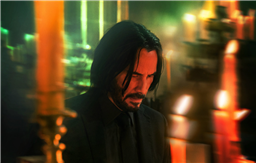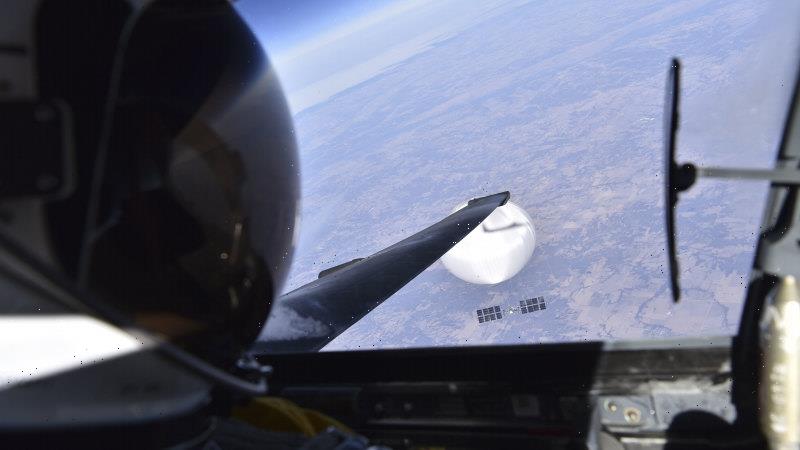In “John Wick: Chapter 4,” the epic culmination of the flamboyantly brutal death-wish-meets-video-game-meets-the-zen-of-Keanu-Reeves action series, our hero finds himself in a Berlin nightclub that resembles a pulsating Bauhaus Eurodisco by way of “Fellini Satyricon.” It’s like a concrete cathedral, with giant mosh pits of dancers throwing their arms up to the heavens as waterfalls cascade down the side walls (it almost looks like it’s raining). But Reeves’ John Wick, as he makes his way through the neon wetness, isn’t dancing. He’s getting ready to start shooting — which, for him, is more or less the same thing. As he skulks forward, oily hair hanging down the sides of his face, the camera glides just ahead of him, framing him like the renegade action demigod he is. We might be in the middle of the world’s most cutting-edge cologne commercial.
Then the fighting begins. It’s built around guns, knives, fists and pure will: anything that can inflict instant death. Wick faces a corpulent foe in gold gangsta teeth and a lavender suit who sucks on an inhaler with the relish of Dennis Hopper in “Blue Velvet.” He will, of course, get what’s coming to him. So will the army of henchmen who are inevitably there to confront Wick, and who will be mowed down like Grand Theft Auto fodder. The hand-to-hand combat in a “John Wick” film is at once relentless and tantalizing in its down-and-dirty realism. Shot in long takes, the action flows enough to earn the term “balletic,” but it’s also vicious enough to be existential. Wick, like Bruce Lee or the heroes of the great Hong Kong action films, never knows what’s coming at him from around the next corner and is always ready to meet it. That’s because he has seen the depths. His reflexes are as fast as his soul is dark.
These days, every franchise seems to get mapped out in advance on a corporate balance sheet, but the “John Wick” movies are the rare series that discovered what it was as it went along. “John Wick,” in 2014, was a sleeper hit — an attempt to revive Reeves’ career with the last sort of role you would have expected him to play. Yes, he’d proved his action combat bona fides in the “Matrix” films, but Wick, the former underworld assassin who can’t seem to cut ties with the series’ fanciful, cult-like, Mob-as-Illuminati hierarchy, was a cutthroat desperado with the taste of sadism in his blood.
What no one could have anticipated is how well the counterintuitive casting worked. Reeves, an actor who even at his most stoic can’t hide his innate likability, was warmer than the role called for — and that’s just what made it connect. His John Wick was a savage badass looking into the abyss…with a quiver of decency. He started off as a noirish antihero, but with each film the series grew more grandiose, as Wick, his name a reference to his short fuse (but it’s also short for “wicked”), got elevated into a kind of superhero. He didn’t have unearthly powers, but he had the quality of invincibility, which is the only superpower you need. “John Wick: Chapter 2” and “John Wick: Chapter 3 — Parabellum” were styled as pulp revels, built around action set pieces that were now knowingly and gloriously over-the-top. It almost didn’t matter if the plot and dialogue were cut-rate. The fans experienced those scenes like drugs.
“John Wick: Chapter 4” is 2 hours and 49 minutes long, but it has a story that, if it were told more briskly, could fit into an 83-minute potboiler that you might have seen in a grindhouse in 1977. Yet the way that Chad Stahelski, the series’ stuntman-turned-director, has staged it, full of hushed, portentous, ritualistic verbal showdowns that are meant to be hypnotic as they build up to each new action scene, “Chapter 4” feels like the first “John Wick” movie that wants to be a Clint Eastwood spaghetti Western. It’s like Sergio Leone crossed with John Woo as seen in Times Square.
The film completes the series’ cosmology with an elemental revenge-meets-liberation plot. Wick is still chained to his obligation to the High Table, the shadow-world consortium that controls…everything. Because of the high crime he committed at the Continental Hotel (a strict breach of High Table law), it’s as if he’s now under lifetime contract to the devil. But the devil has a face: It’s the Marquis de Gramont, a fascist preppie played by the baby-faced Bill Skarsgård (who’s like the young Matt Damon or Stephen Dorff as the world’s most entitled rich kid). And there’s a way out of the contract. Wick can challenge the marquis to a duel to the death, which will take place at sunrise in front of the Sacré-Coeur Basilica in Paris.
That sounds like an easy challenge for a character who kills off hitmen the way most of us eat lunch. There are several catches, though. To make the duel official, Wick must reconnect with his tribal Russian family. And the marquis isn’t going to fight the duel himself. He’ll hand that task over to Caine, a blind High Table assassin endowed with lightning limbs and irresistible presence by Donnie Yen, the Hong Kong mixed martial arts superstar. Caine, who considers Wick his comrade even as he’s assigned to kill him, is as fierce as Wick, and Yen, beneath his aviator sunglasses, gives him a debonair impishness. Filling out the cast is the charismatic Hiroyuki Sanada as the manager of the Osaka Continental, Rina Sawayama as his fighter daughter, Laurence Fishburne as the jaunty, formerly left-for-dead Bowery King, and Ian McShane as Winston, who gets to watch the marquis blow his cherished Continental to smithereens, though McShane then quietly infuses the film with his revenge-is-a-dish-best-served-cold élan.
Is “Chapter 4” too long? You bet it is. At moments, it’s like the action film as liturgical church service. Yet the movie is conceived as a knowingly overstuffed gift to “John Wick” fans, and on that level it succeeds. The marquis keeps trying to assassinate Wick before the morning of the duel, and this results in several delectable fight sequences. One is set in the middle of the speeding centrifugal traffic that surrounds the Arc de Triomphe, one is shot thrillingly from an overhead doll’s-house view, and then there’s the spectacular climax, which unfolds on the Rue Foyatier in Montmartre, the 222-step stairway that leads to the Basilica. With Wick spinning into action (and, at one point, rolling down the entire flight), it becomes an exhilarating stairway to hell, one that winds up delivering John Wick to a gratifying karmic destination he has spent this series earning.
Read More About:
Source: Read Full Article


